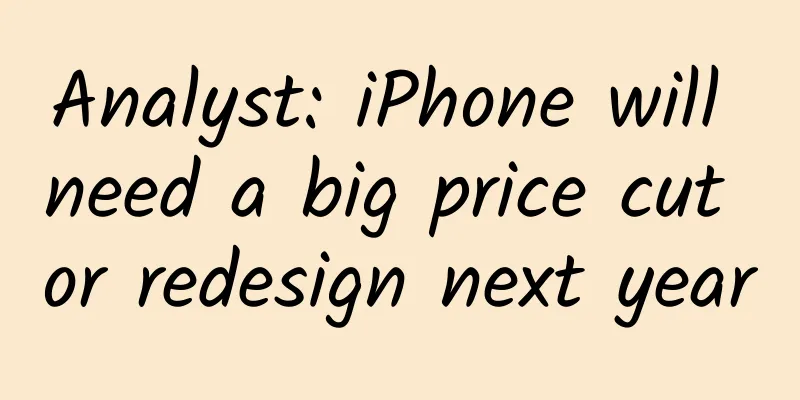Price cuts are a painkiller, but not a cure for the iPhone's decline

|
Daniel Ives, an analyst at the US investment bank Wedbush, said in a report on the 14th that the iPhone will be significantly reduced in price in China in the coming months. He said in the report: "We expect that the iPhone XR will be significantly reduced in price in the coming months. Apple is facing a 'red alert' in the Chinese market. It is crucial for Apple to formulate the right pricing strategy for the iPhone XR and future models of iPhone." Ives said that to achieve Wall Street's "ideal expectations" for Apple's performance, low prices are the prescription. Goldman Sachs analyst Rod Har's previous analysis report had the same view that Apple seemed to have made a serious mistake in the pricing strategy of the iPhone XR, causing sales to fail to meet expectations. Apple is currently constrained by the high price of the iPhone. According to past experience in the mobile phone industry, when pricing power is lost, consumer technology companies either lose profit margins, market share, or both. The mistake in pricing strategy is an important reason for the poor sales of Apple's new phones this year. This has become a consensus in the industry. Unfortunately, Apple still refuses to admit it verbally. Cook also attributes the decline of iPhone more to the overall economic environment, such as the strong dollar, production capacity constraints and weak demand in emerging markets. However, although he refuses to admit it verbally, his body is still very honest. As early as January 10, the iPhone price cut wave had already arrived. According to media reports, channel dealers in Huaqiangbei, Shenzhen, received news of price cuts for iPhone products from the United States. The iPhone XR, iPhone 8 series, iPhone X, and iPhone XS series have all started to drop in price. Among them, the new iPhones at the Yuanwang Digital City Wholesale Market in Huaqiangbei have seen a drop in prices to varying degrees. In addition, the price of iPhone8/8P on JD.com will be reduced to 3999 yuan and 4799 yuan, which is 1100 yuan and 1200 yuan lower than the price of 5099 yuan and 5999 yuan on Apple's official website. Secondly, Suning's official microblog said that it has significantly reduced the price of iPhone products, among which the price of iPhone XR 128GB version is only 5799 yuan, which is 1200 yuan cheaper than the price of 6999 yuan on Apple's official website. Compared with the stability and uncompromising price of iPhone in the past years, Apple today seems to have begun to bow to the market. And judging from the current trend, the days of making money standing still are over. Earlier, Apple lowered its expectations and announced that its revenue for the first quarter of 2019 is expected to be $84 billion, lower than the initial forecast of $89 billion to $93 billion. Based on the current weak sales, in order to save Apple's stock price from falling, the iPhone may continue to adjust its price in the next few months to trigger the group of people waiting to buy to turn to the iPhone again. After all, in the next quarter, Apple may need to rely on sales to prove itself again. With a wave of price cuts in a short period of time, what deep-seated crises are emerging? Back to the question, what is the biggest advantage of iPhone over Android? Of course, an important reason is the fluency and stability of iOS compared to Android, followed by its product quality and brand value retention. Generally speaking, in the past, within six months after the release of a new product, Apple's official website, direct stores, and authorized dealers with independent stores basically maintained the original prices. Even if the prices were reduced, they were generally small drops. It is almost impossible for Apple to experience a price reduction wave like today. Because in the past few years, people have come to the conclusion that Android phones will lag after a long time of use, which means that Apple iOS can maintain its brand premium for a long time. After a year, the price of new products will drop slightly, but it will remain stable overall, while the price of new flagship products in the Android camp will drop rapidly. People will think that Apple's value retention is better than Android, and it is worth the price. But now, Apple has begun to show anxiety on its face as its sales continue to decline. The essence of the iPhone's drastic price cuts is that it can no longer maintain its brand premium. Everyone knows that Apple's iPhone's trump card is iOS, which is also the key link in maintaining the iPhone's brand premium. The reason behind the iPhone's inability to maintain its brand premium is that the advantages of iOS have been weakened. Over the years, with the significant improvement in mobile phone performance and product innovation as well as the smoothness and stability of the Android system, the importance of iOS in people's purchase considerations is no longer as great as before. This actually means that Apple may be facing a real brand crisis. In the mobile phone industry, a decline in sales is a dangerous signal. Once sales decline, the impression given to the outside world is often a signal of decline. So far, few mobile phone manufacturers have been able to rebound from the trend of declining sales and make a comeback. Of course, Xiaomi is an exception. It is just relatively pleasing to see and seize the dividends of the low-end market in India, harvest a wave of sales growth, and cover up the reality of the decline in the domestic market. However, Xiaomi’s shortcomings in product innovation and core technology have not been made up. The layout of the hardware ecological chain is actually a diversion to divert attention, trying to cover up the crisis of the core category with the product layout and sales of new hardware categories. This is similar to when HTC's mobile phones were not selling well, it began to vigorously develop VR to find a new category breakthrough. However, the core competitiveness of the mobile phone product has not been improved. Therefore, once the dividends of the Indian market gradually faded, and the product improvement and innovation of Huawei and OV in China became more obvious, Xiaomi's weakness and fatigue in the domestic market gradually emerged. Therefore, the recent stock price plunge is actually because Xiaomi's performance in the domestic market did not meet the expectations of the capital market. This is a bit off topic. What I want to say is that the weakness of hardware manufacturers is that they rely more on sales to support their brand premium. For the mobile phone market, if we talk about momentum, an increase in market share is a signal of future growth, and vice versa, it is a signal of decline, or at least to achieve stability in sales ranking in the overall market. Under the premise of an unfavorable environment, the market will allow a small decline, but it is difficult to tolerate a sharp decline. Because once a sharp decline occurs in a certain manufacturer rather than the entire manufacturer, it essentially reflects that competitors in the market are rising strongly, and the manufacturer's capabilities and advantages in brand premium, supply chain, product innovation, and core technology have been weakened, and there have been mistakes in the grasp of consumer preferences. This is a manifestation of a deep crisis. For Apple, the mistake in product pricing may be more of a manifestation behind this crisis. Why is price reduction not the real solution? In the long run, price cuts are not the antidote for Apple. On the one hand, after the iPhone lost its rigid demand attributes, the greater crisis lies in the fact that its product hardware performance and innovation level gradually fail to hit the pain points of young people. For example, the low-end iPhone XR lacks sincerity, is severely castrated, has large black borders, and a single camera, which makes its product appearance and quality not match what young people need. In the eyes of young people, this product is not worth its price, but Apple has not realized this demand of young people, but instead placed orders for it as the main shipment machine. In addition, the new iPhone still comes standard with a 5V1A charger, and the battery capacity has been kept below 3000mAh. The popularity of short videos is driven by the fact that young users have increasingly higher requirements for camera and battery life, but the iPhone's camera optimization has not captured the preferences of young users. Android flagships are generally better than the iPhone in terms of camera, battery life, and signal, and their appearance is getting better and better, but the price is several levels lower. Over the past few years, the iPhone's updates have been stuck, the battery life has been slow to catch up, and the camera has lagged behind in other aspects of innovation. In fact, consumers have reached the critical point of aesthetic fatigue with the iPhone. This year, the game of changing shells and high pricing to cheat consumers has reached the point of emotional outburst. Apple's products have gradually deviated from the needs of the new generation of users in some aspects, which Apple has not realized. On the other hand, 5G is coming. Apple's biggest advantage is that the iOS system is smooth, easy to use and fast, although the faster speed mentioned here by 5G refers more to transmission speed and download speed. But to some extent, in the 5G era, faster and smoother may be a basic experience of mainstream 5G mobile phones. Will this weaken the core advantage of Apple's iOS? I think it may. In the 2G and 3G eras, the limitations of software, hardware and communication network conditions had a certain impact on the mobile phone experience. Slowness, lag and unsmoothness became the common intuitive pain points and feelings of Android phones. However, after the arrival of the 4G era, faster network conditions and the progress of system optimization by mobile phone manufacturers have brought certain improvements to the usability and smooth experience of Android phones. In the 5G era, support for low latency and large capacity GB-level, faster network and speed, higher definition and VR live content will inevitably provide a smoother and faster experience, which essentially further weakens Apple's iOS advantage. What does this mean? This may mean that in the 5G era, Apple can no longer rely on the iOS operating system to make a living. It must come up with real highlights in terms of innovation, otherwise it may be really dangerous. When Apple said it would no longer announce sales, it obviously noticed the decrease in iPhone sales, so it raised the price of each product to ensure revenue and profit. This is actually a form of self-harm, because it shrinks the ecosystem around the iPhone while handing over the mainstream mobile phone market below 6,000 yuan. For example, the iPhoneXR left the space below 6K to the mate20, and the XS left the space below 8K to the mate20Pro. Now that sales have plummeted, it has lowered its head and slashed prices, which is actually following the old path of Sony and HTC. In the past, within a few months after the launch of a new mobile phone, the price of the new mobile phone would drop significantly, which would only happen in the Android camp. When the brand premium and product quality of the mobile phone are not enough to support its selling price, under the effect of market supply and demand, its price will be adjusted to a level that matches its value. In the past, whether it was HTC or Sony and other manufacturers, their brand premium was obviously not enough to support its product value. Although these manufacturers artificially set the price of their flagships at a higher level, because its value did not match its price, users did not buy it, resulting in product price reductions within a few months, which in turn reduced the brand premium of these manufacturers. But the result is that users are less and less willing to buy, because in essence, you have destroyed your own pricing system and will cultivate the habit of users to delay purchases or not buy at all until prices drop. But this year, Apple started to slash prices to save the market just three months after launching its new product. This means that the value of the iPhone has not changed, but due to the competition effect, its value has shrunk and is lower than its product pricing. At this time, its brand premium can no longer maintain its price. The iPhone can only fall in price to maintain sales and value. The current impact of Apple's price cuts on the industry is that even if it is effective in the short term, it may not be a good strategy to boost product sales in the long run. The reason why Apple's new iPhone was snapped up in the early stages of the past is because consumers know that the iPhone retains its value well and its price will remain stable in the short term. Two years ago, a 12-month-old iPhone purchased in the US market could still be sold at a 60% discount. In China, the price can be even higher. On the one hand, this shows that Apple set the price of its iPhone at a reasonable level at the time. However, as the gap in system software experience narrowed and hardware performance peaked, the situation of new products being in short supply no longer reappeared. Moore's Law, which had little effect on Apple in the past, began to take effect on Apple, which to some extent affected the value retention of Apple's new products. On the other hand, Apple has always relied on brand influence and premium ability to ensure that its new products maintain their value. Now that Apple's price plunge has set a precedent, users may be more inclined to wait for the iPhone price drop before making a purchase decision. Therefore, Apple may also fall into a vicious cycle of launching new iPhones - insufficient product innovation - users are not satisfied with the high price - sales inertia declines - price plunges - brand premium declines. So, the market is really subtle. In the case of weak product innovation, the high pricing strategy has become the first domino that pushes Apple down. Once it starts to go down, price reduction measures to save the market often become ineffective. What Apple needs to do is to adjust the second link (product innovation system) and the third link (new product pricing strategy) mentioned above, break its vicious cycle system, re-examine its product innovation mechanism, supply chain system and pricing system, rethink consumer needs and pain points, and balance the relationship between short-term profits and market share. The current price cut is a painkiller, but it is not the ultimate cure for the decline in sales. |
<<: Three social products are attacking WeChat, and Duoshan and MaChong are all dead?
>>: “WeChat ban” is an obstacle that Chinese Internet companies cannot avoid
Recommend
Case | Super practical account optimization strategy for the decoration industry
This article shares with you the super practical ...
Which of the weird courtship behaviors in the animal world breaks your imagination?
Spring has come, everything is reviving, and it i...
"China's Sky Eye" has discovered more than 800 new pulsars and entered a period of explosive growth →
The reporter learned from the FAST Operation and ...
Digital RMB pilot, ATMs also have development opportunities? Can you withdraw digital RMB?
After mobile payment became popular in my country...
Live broadcast room promotion strategy!
On the first day of our involvement, the effect w...
Kobe Bryant endorses Ele.me, and it only takes five steps to pass the level!
These days, Kris Wu is the spokesperson for Honor...
APP Promotion: Practical Thoughts on Low-Cost Growth of Financial Apps!
Scenario—Creativity—Benefit Point—Cycle—Channel, ...
The Samsung phone that even Do Min Joon can’t save
When Samsung mobile phones were frequently expose...
Lanzhou Mini Program Mall promotion and traffic diversion, how to promote WeChat Mini Program Mall?
Recently, many customers have sent private messag...
The 40 most popular Android open source projects on GitHub source code packaging
Source code size: 23MB Source code category: Dome...
Chengdu tea drinking resource group, a good place to drink tea
Appointment arrangements for the Chengdu tea drin...
Photovoltaic power stations float on the ocean. Will we rely on the sea for food in the future?
Can solar panels only be laid on land? No! They c...
Doushang Commune Live Streaming Growth Camp teaches you how to quickly monetize through live streaming
Doushang Commune Live Streaming Sales Growth Camp...
Can breaking bones really increase height? It's not that simple
Growing taller is a beautiful wish of many friend...
600 stores’ private live broadcasts summarized these 6 live broadcast methods!
With the popularity of the live streaming industr...









